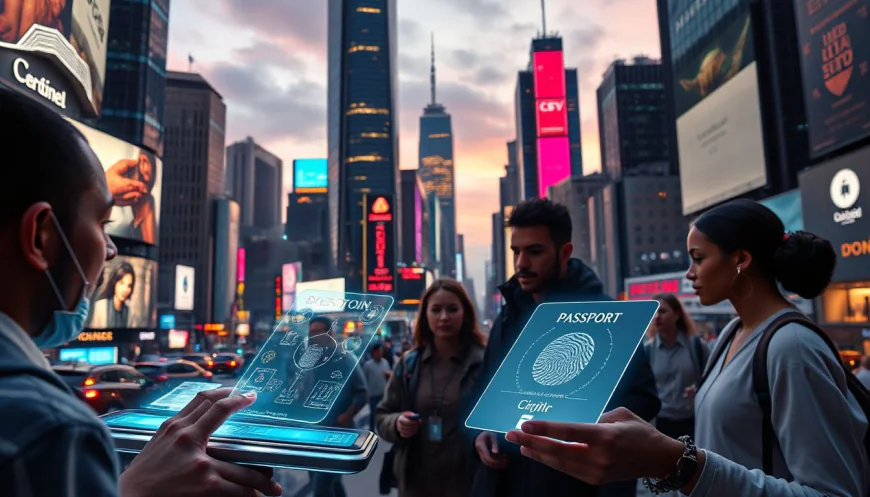The Rise of Digital Identity: From Biometrics to Blockchain Passports
Digital identity has become a key part of how we live, travel, and do business today. It is changing the way we prove who we are. As more services go online, verifying identity quickly and securely is more important than ever. Technologies like biometrics and blockchain are leading this shift. They promise to make identity checks easier, safer, and more private. This article looks at how digital identity has grown, where it’s headed, and the key tech behind these changes.

The Evolution of Digital Identity: From Traditional to Digital
Historical overview of identity verification methods
In the past, proving who you were mainly meant showing paper documents—birth certificates, ID cards, or passports. These physical forms could be lost, stolen, or faked. For example, forged driver’s licenses have been used to open bank accounts or enter buildings illegally. Paper-based IDs often failed to stop fraud and were slow to verify.
Transition to digital identity solutions
As the internet grew, new systems started to replace paper IDs. Early digital IDs were simple login credentials—like usernames and passwords. Over time, governments and companies wanted safer options. The push came from the need for better security, convenience, and the chance to do business across borders more easily. Countries began launching digital ID projects and online verification tools.
Impact of technology advancements on identity verification
Advances such as smartphones, internet connectivity, and cloud storage made digital IDs more practical. Now, we expect our digital interactions to be quick and safe. The ability to verify identities remotely has transformed many industries. Now, a person in one country can prove who they are to a service in another — instantly.
Biometrics: The Foundation of Modern Identity Verification
Types of biometric authentication
Biometrics use physical or behavioral traits for ID:
- Fingerprints: Common on smartphones and security systems.
- Facial recognition: Used in airports and smartphones.
- Iris scans: More precise, often for border control.
- Voice recognition: Used in banking and customer service.
Each has pros and cons. Fingerprints are easy but can be copied. Facial scans are fast but may have privacy issues. Iris scans are secure but expensive.
Adoption of biometrics worldwide
Biometrics are everywhere today:
- Airports use facial recognition to speed up check-ins.
- Smartphones like iPhone use Face ID for unlocking.
- India’s Aadhaar system links biometric data to government ID, helping aid reach millions of unbanked people.
Privacy and security concerns
Collecting biometric data raises risks. Hacks could expose sensitive info, leading to identity theft. Ethical questions about consent and data use are also raised. Governments and companies now implement strict rules to protect biometric data, like encryption and access controls.
Blockchain and Decentralized Digital Identities
Fundamentals of blockchain technology
Blockchain is a digital ledger spread across many computers. It uses cryptography to keep data safe. Once stored, info can’t be changed easily, ensuring trust. Its decentralized nature makes hacking or tampering difficult.
Blockchain-based digital identity solutions
New apps let users control their identity data. Instead of giving a company all their info, users provide only what’s needed. Self-sovereign identity (SSI) systems like Sovrin or uPort put users in charge of their data. Companies like Civic build platforms for secure digital IDs.
Benefits over traditional systems
Blockchain tech offers more privacy control. It reduces identity fraud by making fake IDs harder to create. Estonia is building an e-residency program that uses blockchain for secure online identities. For businesses, adopting blockchain identity solutions improves security and reduces administrative costs.
Blockchain Passports: The Future of International Travel
Concept and development of blockchain passports
Imagine traveling with a digital passport stored securely on your phone. This is the idea behind blockchain passports. Projects like the IATA Travel Pass test this concept. They store your identity and vaccination info securely on blockchain, making travel faster and safer.
Advantages for travelers and authorities
Blockchain passports can cut down wait times. Border checks become quicker, and identity fraud decreases. They enable safe data sharing across countries, streamlining travel within legal limits. You get privacy options while authorities benefit from accurate identity info.
Challenges and considerations
Privacy worries still exist. What if authorities misuse data? Standard rules for interoperability are needed so these passports work worldwide. Governments are exploring how to create regulations that support these innovations. Industry leaders stress the importance of international standards and user privacy.
The Broader Impact and Future Trends
Digital identity and financial inclusion
Many people worldwide lack bank accounts. Digital IDs can change that by providing proof of identity needed for banking, loans, and more. That helps reduce poverty and fight scams. Plus, secure IDs protect against cybercrime and theft.
Emerging technologies shaping the future
Smart AI tools are helping verify identities faster. Zero-knowledge proofs let someone prove they’re trustworthy without revealing details. The Internet of Things (IoT) could soon use digital IDs to connect smart devices securely and privately.
Policy and ethical considerations
We need rules about who owns data, whether people can control their info, and how it’s shared. Governments must lead with fair standards. Building trust with users means making digital IDs safe, transparent, and easy to use.
Conclusion
From simple paper IDs to advanced blockchain passports, digital identity options keep growing. They promise better security, privacy, and convenience. But we must also keep user rights and data privacy in mind. The future of digital IDs holds the key to smoother travel, better financial access, and more secure online experiences. Stakeholders—from governments to tech firms—must build flexible, secure, and user-first digital identity systems. Doing so will help create a connected world where identity matters less as a barrier and more as a tool for progress.



 VARSHITHA
VARSHITHA